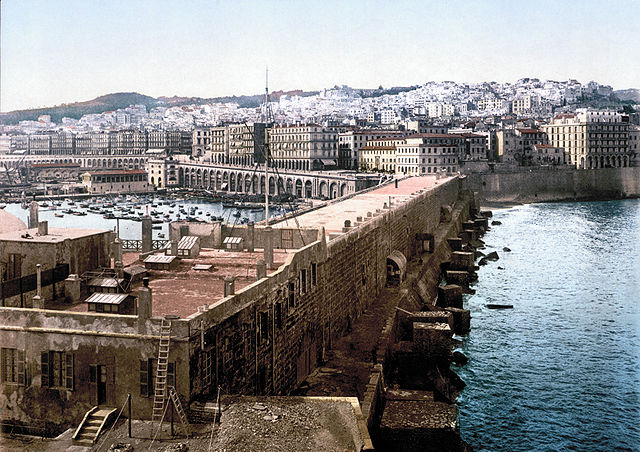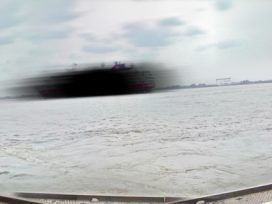Despite the abundance of studies on port cities, their historical relation to international migration remains to be established. The reality is that port cities pioneered human migrations and remain relevant for returnees. While air travel is the dominant form of mobility between Mediterranean countries today, migrants continue to use maritime routes. In the North African region, the majority of travel between Morocco and Spain takes place across the Straits of Gibraltar. In the 1990s, a heavy concentration of North African populations built up along the southern shore of the Mediterranean (an average of 44 per cent), a concentration that is still greater still for Algeria (66 per cent). Yet the links between Algeria’s ports and the rest of the world are little known when it comes to the question of mobility.
It is true that much has been written about the city of Algiers and all the facets of its character as a town (René Lespes, 1930); Jean Deluz, 1988) Likewise many writers have paid particular attention to the attraction that Algiers has held as a target for migration for those living in the hinterland. These authors have spoken exclusively about internal migration. But the city’s role as a port is still largely undocumented. The relationship between the city and international migration likewise remains a matter of anecdote. To the best of my knowledge, there are no sociological studies on city life that focus on Algeria’s port cities.
Algiers, as a port city, has three functions (capital, port and city), making it a highly complex urban issue throughout the history of the country. Is it not the case that Algiers’ role as a port has been a determining factor in the development of the city of Algiers? Was it not through sea routes that the military and economic influence of Algiers was able to spread under the Ottoman Empire and later as a French colony? And was it not so that this spatial development and historical influence acted as driving forces behind international migration? These are the questions that provide the structure for the discussion of international migration and the role of Algiers as Algeria’s capital and as harbour city.

Algiers harbour, 1899. Photo: Wikimedia
Relations between cities as ports and migration
There is a vast literature on relations between cities and their role as ports, especially from geographical and economic viewpoints. Port cities have been examined in relation to three key concepts: centrality, nodality and reticularity. These indicators are related to the port’s functions (especially transport activities) and to urban development. Migration has yet to be included in any consideration of these two factors. Yet the growth of a town is often attributed to its ability to attract surrounding populations, in other words internal migration. Links with international migration are matters of historical fact for the development of port cities, since initially they offered the only opportunity for people and goods to cross maritime frontiers.
Once terrestrial and aerial means of transport became possible, espaces-monde (world spaces) appeared, to use Fernand Braudel’s term. Recently, Saskia Sassen has suggested seeing cities as part of the process of globalization through the prism of migrations, employing the concept of the “global city”. Seen thus, port cities take on prime importance in international migration for those territories that are not landlocked. In this sense, Algiers, capital of Algeria in North Africa is an interesting case. Let us spend a short time considering how this city came to exist under the Ottoman Empire and under colonial rule before examining the development of migratory flows, particularly during the colonial period.
Port functions and Algiers’ raison d’être
The refounding of the city of Algiers under the Ottoman Empire between the sixteenth and nineteenth centuries is not unrelated to its role as a port. The casbah (Arabic for “citadel”) was built by Turkish corsairs on a site that sloped down from the hills towards the seashore. The activities of the port were the region’s only link with the rest of the world, as was the case everywhere else at this time. The port was heavily militarized, with batteries of cannon sited on both sides to provide defence for the town. The population mix in Algiers at the time was multi-religious (Arabs, Jews and Christians). The various quarters of the city also signified social and cultural distinctions around private and public spaces.
The capture of the city by France in 1830 was to lead to the conquest of the whole of Algeria. This change of rule also bring about changes in the layout of the town. The lower casbah, which gave onto the port, was completely razed to the ground with the exception of a few residences and other buildings. A new and “modern” city was built that would be the new centre of the country. Its role as a port was strengthened, this time through considerable commercial activity and through flows of migrants from the north to the south. The first links between the ports of Marseille and Algiers were established for economic reasons and for the purpose of migration. The new city held the majority of foreigners, whilst almost all of the native populations were confined to the medina (or casbah) and to shanty towns in the outskirts.
From the time of the Ottoman protectorate up to the colonization by the French, the port of Algiers was able to carry on its vital functions as a centre for trade and the movement of foreign peoples to Algeria. During the colonial period, migration to, from and within Algeria became more intense still.
Migratory flows in the colonial period
The city of Algiers acted as a magnet not only for external migration (Europeans in particular) but also for internal migration. This double attraction was responsible for the social and cultural heterogeneity of Algiers. The population of Algiers during the first years of colonization (1847) was around 103,000 inhabitants, of whom two-thirds were Europeans. The initial population (bourgeois city-dwellers) was, according to Pierre Bourdieu essentially made up of “Turks, Koulouglihs (descendants of Turks), Andalusian Moors (expelled from Spain), Arabs and Berbers”.
The predominance of Europeans was to be confirmed at the beginning of the twentieth century. In 1926, the population of Algiers was put at 90,000 whilst the percentage of Europeans had gone down slightly to 62 per cent. In 1954, the year that the Algerian revolution began, the population of Algiers was estimated at 570,000 of whom 51 per cent were native. According to Farouk Benatia, 29 per cent of the Muslim population were huddled together in the 16 shanty towns around Algiers. The growth of the town was primarily linked to the double phenomenon of migration: the European colonists and the natives mainly from the central and eastern regions of Algeria. The casbah attracted people from Kabylia in particular.
This period also witnessed the beginning of emigrations from Algeria to France organized by the colonial authorities. Records of departures and arrivals between Algiers and Marseille are evidence of two-way traffic of emigrants to France and immigrants to Algeria. The available statistics of departures and arrivals during the colonial period are overall and unspecific; it is not easy to distinguish between the methods of transport used (air or sea).
In structural terms, the port of Algiers was also to undergo developments aimed at providing defences for the town. Algiers thus continued to be a town fortified against any aggressive seaborne intent. This strengthening of its military function was also motivated by the desire to protect its economic role. Eastward extension of the port shifted the town’s centre from the medina towards the new European town. It was by sea routes that almost all export trade was carried on, destined for French ports and mainly for Marseille.
From independence to the present day
Algeria’s independence was to be marked by a specific event that would make Algiers an exception on the African continent. The Évian Accords that ended the war of independence made cohabitation between Europeans and native Algerians possible. But the majority of the Europeans (and the “harkis”) were forced to leave Algeria following the declaration of independence. In 1962, the port of Algiers witnessed extraordinary scenes, with masses of human beings embarking for a one-way voyage, most to France. Only a minority of foreigners, those who had espoused the Algerian cause, were to remain in Algeria.
Appropriation of the city’s spaces by Algerians happened at speed. By 1966, Algiers grew rapidly to a million inhabitants. This growth would continue, so that by 2008 it reached over 3 million. Activity in the port of Algiers, despite regression, is still considerable. Algeria now has specialist ports for the transport of goods and hydrocarbons. The port of Algiers also competes with Bejaia (to the east of Algiers) and it is through Bejaia that migrating populations, especially those from Kabylia, tend to travel. Recent figures from the port of Algiers show that it still dominates over Algeria’s other ports, in terms of both the transport of goods (hydrocarbons excluded) and of passengers.
Algiers, an evolving metropolis?
Algiers is in danger of experiencing the same kind of clashes between the development of the city and the growth of the port as every other major harbour city in the world. The decline in the activities of the port coincides with a tendency for the bay of Algiers to be taken over for leisure and tourist use. The development of other means of transport for exports, for example fuel pipelines through Morocco to Spain and through Tunisia to Italy, have also contributed to the decline of port cities in Algeria.
The seafront, which hitherto was not urbanized, offered every opportunity for an extension of the activities of the port. But now the seafront is experiencing a variety of takeover bids. The recent opening of the “Medina Business Centre” to the east of Algiers is just the prelude to this development. Investors from the Gulf States have presented a grandiose development plan for the bay of Algiers, involving the building of business centres and skyscrapers.
At the heart of the redevelopment of the port city is the question of the casbah, listed as a UNESCO World Heritage Site. The casbah, which expresses the symbiosis between the city and the port, is undergoing a series of restoration processes. The first tourist itinerary, starting from the citadel, passing through the casbah, then below the Place des Martyrs, to arrive at the museums and the major restaurants of the port of Algiers, is already close to completion. Alongside the process of remodelling the urban functions of the port and the bay is an extension of the town towards the heights of the hills of Algiers, with the creation of facilities to provide a structure, such as the Dounya Parc and the new Algiers Opera.
Achieving this redistribution of urban functions between the port area and the hinterland necessarily involves displacing populations, whether voluntarily or by force. Because there is now a greater variety of methods of transport available, a greater degree of mobility becomes possible. For example, the first inhabitants who were uprooted from the Casbah and rehoused in Bachdjarah (a huge dormitory estate on the periphery of Algiers), can now travel by tram and then by metro to the town centre and also be linked to the cable-cars that go up to the heights of Algiers.
The reduction in intensity of port activities in Algiers has been accompanied by a decline in “regular” migratory flows by sea. Nowadays, migrants tend to arrive in Algeria by air – especially from China and India. “Irregular” migratory flows are observed in particular across land frontiers, through the frontier town of Tamanrasset. “Refugees” from sub-Saharan Africa have also begun to arrive in Algiers.
Nevertheless, the port of Algiers still services a large number of passengers, especially from the Algerian community living in Europe. The port of embarkation appears to be Marseille. It is also Marseille that serves other ports in Algeria (Oran, Annaba, Béjaia), thereby reducing the traffic through Algiers.
Algiers and returning migrants
In terms of migration, the port of Algiers makes for a particularly good vantage point for surveying migrants who are returning to Algeria and likewise those immigrants who are going back to their country of origin. It was with this in mind that we carried out a survey of returning migrants in 2007, using two sources. First, the data on passengers (embarkation, landing) provided information on mixed migratory flows, including tourists and persons in transit. Second, in order to define migrating populations, we carried out a survey amongst migrants (at the port of Algiers and the airport) and members of their families in Algeria on their return. We also used administrative data from the customs service in the port of Algiers. This enabled us to establish details about migrants moving from abroad to Algeria or from Algeria to abroad. The change of place of residence from one country to another, involving customs clearance of all their personal effects (furniture, household equipment, cars, etc.) means that sea transport remains the preferred route for migratory flows (both inward and outward).
Looking at Algiers’ function as a port alongside an observation of migratory flows enables a re-examination the history of an aspect that has received but little attention hitherto. It is true that culturalist approaches to daily life around ports have been abundant but they do not make it possible to observe migratory flows in quantitative terms. Socio-historical analysis of this port city has much to teach us about the past, but it is future developments that are of the greatest interest. The case of Algiers signals a break with the colonial city but forms part of present-day trends towards “metropolization” – a process that, as is illustrated by the Casbah of Algiers, has its limitations. Carrying out the survey of returning migrants turns out to be a fertile source for producing a picture of port cities in relation to migrations in modern times.








